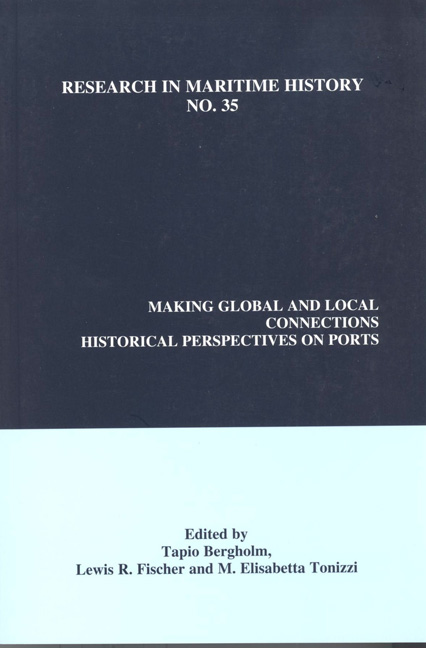Book contents
- Frontmatter
- Contents
- Contributors' Notes
- Contributors
- “Introduction”
- Part I Port Case Studies
- Part II Port Systems
- “The Northwest Portuguese Seaport System in the Early Modern Period”
- “Discourse and the Container Revolution in Finland in the 1960s and 1970s”
- “The Ports of Northern Chile: A Mining History in Long-run Perspective, 1880-2002”
“The Ports of Northern Chile: A Mining History in Long-run Perspective, 1880-2002”
from Part II - Port Systems
- Frontmatter
- Contents
- Contributors' Notes
- Contributors
- “Introduction”
- Part I Port Case Studies
- Part II Port Systems
- “The Northwest Portuguese Seaport System in the Early Modern Period”
- “Discourse and the Container Revolution in Finland in the 1960s and 1970s”
- “The Ports of Northern Chile: A Mining History in Long-run Perspective, 1880-2002”
Summary
Changes in the distribution of economic activity in Chile between the late nineteenth century and the present have been quite substantial. The exploitation of a plethora of mineral resources in the north and central parts of the country, the development of an industrial sector and a strong trend toward urbanisation in the second third of the twentieth century have produced a complex commercial flow which combines foreign and domestic trade. Moreover, Chile's geography and topography have required a considerable amount of this commerce to be carried by sea. For these reasons, an examination of the country's ports is a useful way to understand its trade.
In this essay I want to focus on the northern region of Chile where important mining deposits have led to particular production and commercial structures that in turn created a distinct population distribution. The export of nitrates and copper have drawn this area into a global trading system in which export earnings have been used to pay for the import of manufactured goods that arrive through the ports. Indeed, shifts in world commodity markets have had a direct impact on the fortunes of harbours; some have specialised in exports, others in transhipment and distribution, and some have disappeared.
This study focuses on Norte Grande and Norte Chico (the provinces of Tarapacá, Antofagasta, Atacama and Coquimbo), which include thirty-four ports that engaged in coastal commerce, twenty of which also participated in foreign trade throughout the period (see figure 1). The data used to analyse maritime commerce comprise the total value of all entrances and clearances. For domestic trade we also have tonnage data. I have also examined the structure of this commerce for several years. While it is possible to analyse exports until the 1990s, we can only go to about 1960 for domestic trade (although tonnage data allow us to say something about this to the present). I also want to look at the impact of natural resources on industry and population. For this I have compiled evidence on industrial occupations by sectors and provinces and on population by province and by urban versus rural districts.
- Type
- Chapter
- Information
- Making Global and Local ConnectionsHistorical Perspectives on Ports, pp. 153 - 170Publisher: Liverpool University PressPrint publication year: 2007

